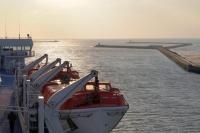
By Nick Yatsenko, Master Mariner
During my life at sea, I was always anxious during lifeboat drills. One of my relatives was employed on a MSC container carrier as an Engineer Watchkeeper, and during his routine inspection inside the free-fall lifeboat, the craft suddenly released and fell into the water while a ship was underway.
He was lucky enough to survive and suffered only severe injury to his knee, and since the vessel was close to the shore so he was evacuated by the helicopter. In the hospital, he had a surgery and then spent another year recovering.
When I was working for Maersk Line, one of our ships reported that a rescue boat accident resulted in one crewmember being killed instantly. Another crewmember was seriously injured.
Unfortunately, there is no comprehensive statistics on lifeboat accidents, but there is an ample amount of research showing a scary outcome. To name a few studies, from 1992-2004, marine insurer Gard “recorded 32 cases of accidental release of lifeboats. Five cases were without injury to people (there are certainly much more, but these five have been reported because they involved P&I claims), the others caused 12 deaths and injury to 74 people. Among the people injured there were several very serious cases of head and spine injury, some causing paralysis or possibly leading to death at a later stage. There were also a few cases where members’ vessels have picked up drifting lifeboats at sea – boats which had obviously fallen from the ships they belonged to.”
In 2001, the Marine Accident Investigation Branch (MAIB) published a review of a lifeboat and launching systems accidents covering a 10-year period from 1991, where seven people were killed and 10 injured.
As the most of the accidents occurred during routine drills and maintenance activities, the main causes are design failure, lack of maintenance, and lack of proper training. “The equipment failure was reported to be the most common cause of accidents, within which quick release mechanism failure was identified as the most frequent cause,” according to a report by the Nautical Institute.
In response to the growing number of lifeboat accidents, the IMO has released new SOLAS Regulation III/1.5 and the amendments to Chapter IV of the LSA Code concern on-load release mechanisms fitted to new and existing cargo and passengers vessels. SOLAS Regulation III/1.5 also specifies other important dates:
“For ships constructed on or after 1 July 2014, on-load release and retrieval systems shall comply with the LSA Code, as amended by Resolution MSC.320(89); and
Member Governments are encouraged to ensure that ships constructed on or after 20 May 2011 but before 1 July 2014, on-load release and retrieval systems shall comply with the LSA Code, as amended by Resolution MSC.320(89).”
For vessels constructed prior to 20 May 2011, any on-load release systems that do not comply with paragraphs 4.4.7.6.4 to 4.4.7.6.6 of the revised LSA Code must be replaced at the first scheduled drydocking after 1 July 2014, but no later than 1 July 2019.
For the ships which are awaiting for the modification or fitting of the new design on-load release mechanism, the IMO has issued the “Guidelines for Evaluation and Replacement of Lifeboat Release and Retrieval Systems” and advise that Fall Preventer Devices (FPDs) are to be used with each existing RRS, in accordance with MSC.1/Circ.1327 “Guidelines for the Fitting and Use of Fall Preventer Devices (FPDs)”.
Some of the current requirements for the lifeboat/rescue boat inspections and maintenance are:
Davit-launched lifeboats weekly moved from stowed position (SOLAS III/20.6.3)
Monthly rescue boats other than a lifeboats launching (SOLAS III/19.3.3.6)
Quarterly launching lifeboats & rescue boats (SOLAS III/19.3.4.3 & .6, MSC/Circ. 1206)
Six monthly free-fall lifeboat drill (SOLAS III/19.3.4.4, MSC/Circ. 1206)
Considering all the accidents, do you think it is viable to break the boats from its stowed position every week? Or even worse to launch them with the crew inside every 3 months?
The Marine Accident Investigation Branch (MAIB) went even further and recommended that the IMO undertake a study on the present value, need and desirability of lifeboats.
While I’m not ready to argue the present value of the lifeboats, I’m confident that only a change in on-load hooks design is not good enough. Many accidents occurred due to the failed winch operation, damaged wire or some minor imperfection such as remote wire control. I believe more radical changes are required, for example:
Reduce requirement for the davit-launched lifeboats to be moved from stowed position from weekly to monthly or even quarterly.
Reduce the launching of the lifeboats & rescue boats from quarterly and monthly respectively to annually. Or even more radically, test the off-load and on-load release mechanism by shore contractor only while the boat in stowed position, of course with the additional securing arrangements. Therefore completely removing the requirements to launch the boat with the crew inside.
The crew has been trained how to use the survival craft during their STCW courses which are compulsory. During the external inspections the inspector, such as port state control can test the knowledge by asking relative questions. I’m very confident that in a case of emergency the crew would be able to lower the boat, start the engine, let go the hooks and steer away from the vessel.
Sourced byhttp://nickyatsenko.com/blog.
![[ad-side]](http://www.crewing24.com/ad_images/48_banner.jpg)
![[ad-side]](http://www.crewing24.com/ad_images/89_banner.png)
![[ad-side]](http://www.crewing24.com/ad_images/106_banner.jpg)
![[ad-side]](http://www.crewing24.com/ad_images/82_banner.jpg)
![[ad-side]](http://www.crewing24.com/ad_images/93_banner.jpg)
![[ad-side]](http://www.crewing24.com/ad_images/110_banner.png)
![[ad-side]](http://www.crewing24.com/ad_images/95_banner.gif)
![[ad-side]](http://www.crewing24.com/ad_images/85_banner.jpg)
![[ad-side]](http://www.crewing24.com/ad_images/80_banner.jpg)
![[ad-side]](http://www.crewing24.com/ad_images/94_banner.png)